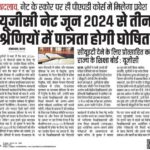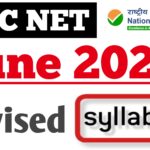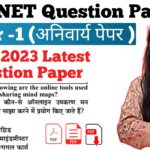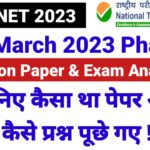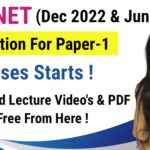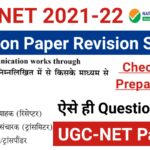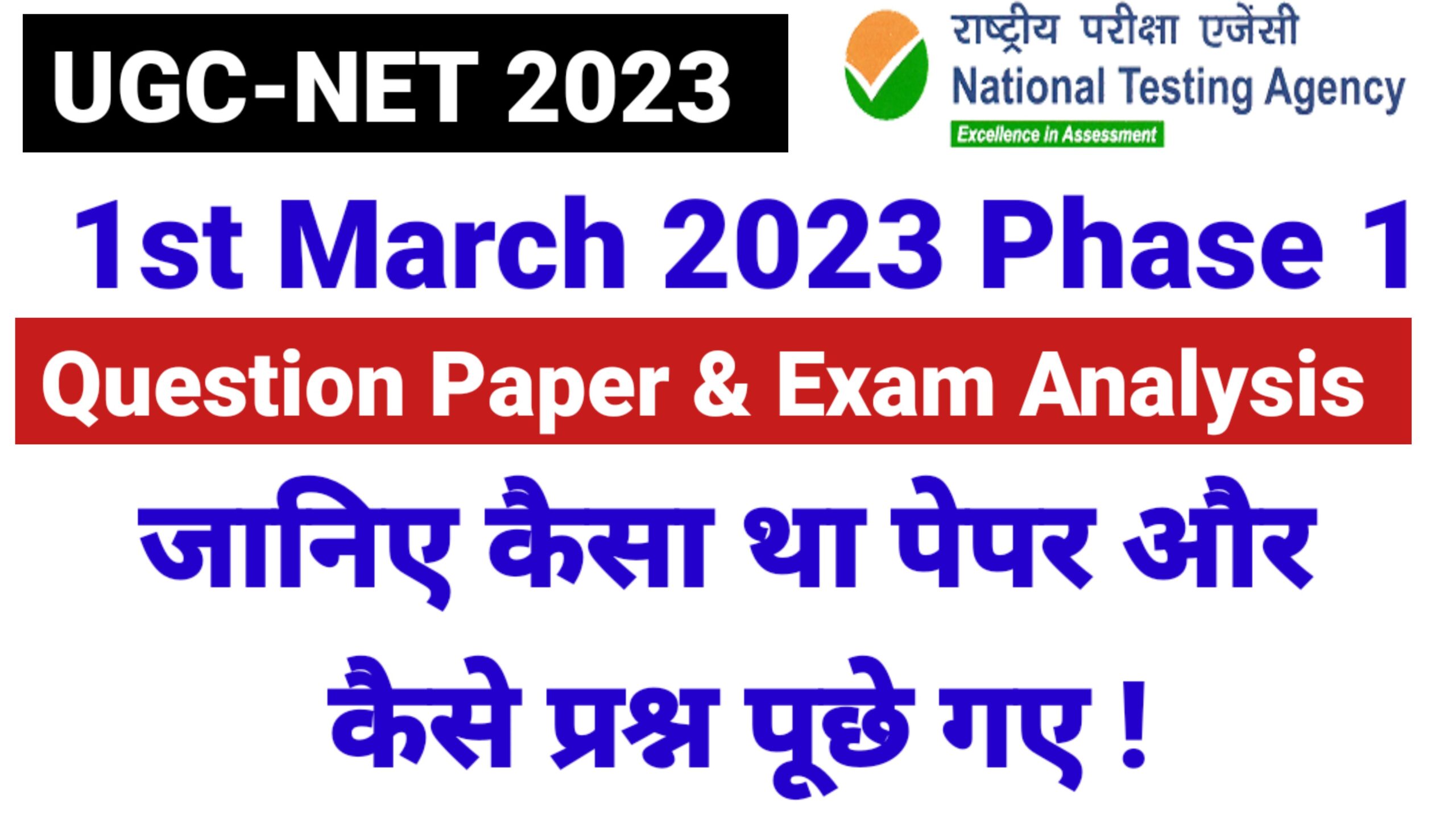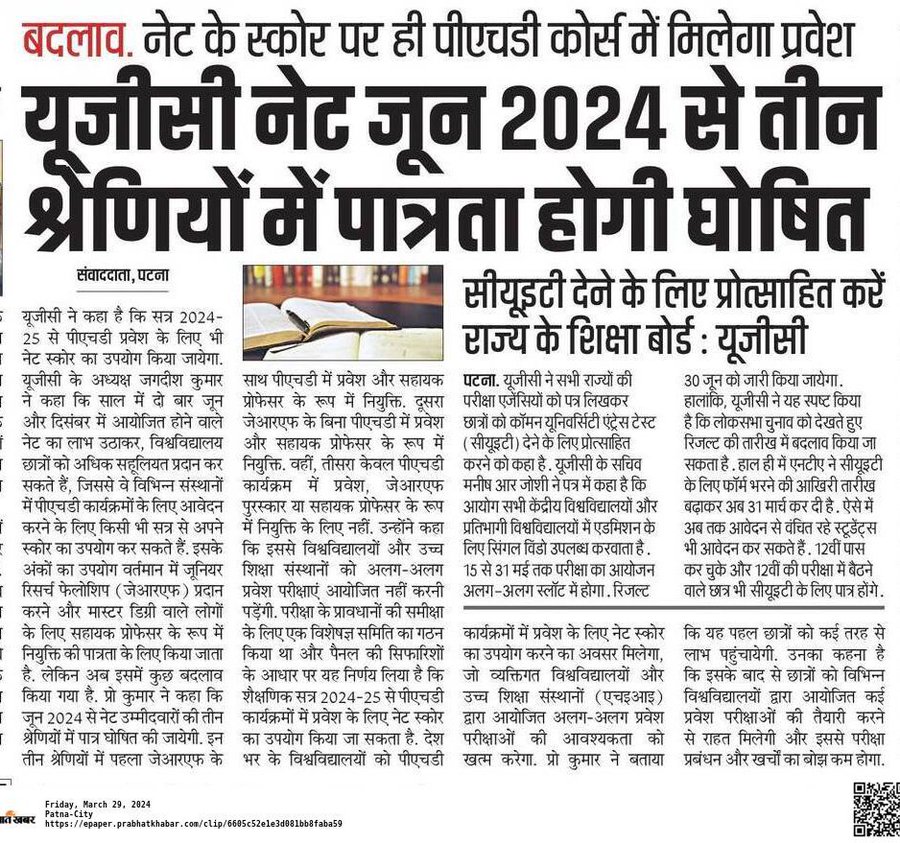Here is a detailed analysis of the UGC NET 1 March 2023 Exam Analysis . Candidates will find all the topics asked in the question paper along with the number of questions asked from each section and their difficulty level. Overall, the difficulty level of the question paper was easy to moderate.
UGC NET 2023 Paper Analysis
UGC NET 2023 Paper Analysis has been mentioned in below article subject wise. UGC NET paper I will include 10 sections which include Teaching Aptitude, Research Aptitude, Comprehension, Logical Reasoning, Data Interpretation, Math’s, Communication, Environment, People & Development, Higher Education and Information Technology. UGC NET 2023 Paper Analysis for Shift 1 and Shift 2 topic wise and asked question has been mentioned below.
| Subjects | UGC NET Paper 1 |
| Teaching Aptitude | Bloom Psychomotor Domain, Learner Characteristic, Direct and Indirect Teaching, Levels of Teaching, Models Of Teaching(Matching ) ,Learning Theories. Swayam Fill in the blanks , |
| Research Aptitude | SPARC Full Form , Type of Research, research methodology, Qualitative Research |
| Comprehension | Unseen passage on Child Development |
| Logical Reasoning | Coding Decoding, Assertion Reason, Pramana, Fallacy , Classical Square of Opposition |
| Data Interpretation | %/ Average based Question |
| Maths | Number Series, Alphabetical Series, simple Interest |
| Communication | PYQ, Barriers of Communication, Public Communication , Verbal & Non-Verbal Communications, Types of Communication, Process of Communication, Synchronous and Asynchronous Communication |
| Environment | Oxygen Demanding Wastage ,Atmospheric haze from people development environment ,Types of Gas ,water /Air Pollution |
| People & Development | Water pollution, SDG, Kyoto Protocol, Paris Agreement Sequence |
| Higher Education | NEP 2020 language ,SDG ,Ancient Education -Upanishad |
| Information Technology | Web 2.0 , Laser ,Inject Printer ,LED LCD Full form ,Question Related to Cookies ,Memory Hierchy , WAV Full form -Audio file format ,Excel Sheet |
The three domains of Bloom’s taxonomy are:
- Social, Affective and Psychomotor
- Cognitive, Affective and Psychomotor
- Cognitive, Affective and Evaluation
- Cognitive, Pedagogy and Psychomotor
“Automated, unconscious mastery of activities and related skills at strategic level” with reference to classification of objectives of learning in the psychomotor domain proposed by R.H. Dave means
- Manipulation
- Articulation
- Naturalization
- Precision
आरएच दवे द्वारा प्रस्तावित साइकोमोटर डोमेन में सीखने के उद्देश्यों के वर्गीकरण के संदर्भ में “रणनीतिक स्तर पर गतिविधियों और संबंधित कौशल की स्वचालित, अचेतन महारत” का अर्थ है
- चालाकी
- जोड़बंदी
- समीकरण
- शुद्धता
विकल्प 3: प्राकृतिककरण
LED LCD
| It is constructed with the semiconductor material and emits light when current flows through it. | This is an optic device that displays information in the shape of pictures and numbers. |
| It stands for a light-emitting diode. | It stands for liquid crystal display. |
| In this module, there is no backlight required. | It uses a fluorescent lamp for a backlight. |
| Its resolution is high. | Its resolution is less. |
| It consumption power is high | its power usage is less. |
| Its displaying area is less compared to LCD. | Its displaying screen is large. |
| This device is expensive. | it is less expensive. |
| It manufactured with the gallium arsenide phosphide. | It constructed with the liquid crystal and glass electrodes. |
| Its switching needs less time. | Its switching is a slow speed |
| It can also operate on Direct current. | DC can damage its operating life. |
| It does not use mercury | It uses mercury. |
एलईडी एलसीडी LCD
| यह सेमीकंडक्टर सामग्री के साथ बनाया गया है और जब करंट प्रवाहित होता है तो यह प्रकाश का उत्सर्जन करता है। | यह एक ऑप्टिक डिवाइस है जो चित्रों और संख्याओं के आकार में सूचना प्रदर्शित करता है। |
| यह प्रकाश उत्सर्जक डायोड के लिए खड़ा है। | यह लिक्विड क्रिस्टल डिस्प्ले के लिए खड़ा है। |
| इस मॉड्यूल में बैकलाइट की आवश्यकता नहीं है। | यह बैकलाइट के लिए एक फ्लोरोसेंट लैंप का उपयोग करता है। |
| इसका रेजोल्यूशन हाई होता है। | इसका रेजोल्यूशन कम होता है। |
| इसकी खपत शक्ति अधिक है | इसका बिजली उपयोग कम है। |
| इसका डिस्प्ले एरिया LCD की तुलना में कम होता है। | इसकी डिस्प्ले स्क्रीन बड़ी है। |
| यह डिवाइस महंगा है। | यह कम खर्चीला है। |
| यह गैलियम आर्सेनाइड फॉस्फाइड के साथ निर्मित होता है। | इसका निर्माण लिक्विड क्रिस्टल और ग्लास इलेक्ट्रोड से किया गया है। |
| इसके स्विचिंग में कम समय लगता है। | इसकी स्विचिंग धीमी गति है |
| यह डायरेक्ट करंट पर भी काम कर सकता है। | डीसी इसके परिचालन जीवन को नुकसान पहुंचा सकता है। |
| इसमें पारे का प्रयोग नहीं होता है | इसमें पारे का उपयोग होता है। |
Which of the following statements is true?
- A web cookie is a small piece of data sent from a website and stored in user’s web browser while a user is browsing a website.
- A web cookie is a small piece of data sent from user and stored in the server while a user is browsing a website.
- A web cookie is a small piece of data sent from root server to all servers.
- None of these
निम्नलिखित बयानों में से कौनसा सच्चा है?
- एक वेब कुकी एक वेबसाइट से भेजा गया डेटा का एक छोटा सा टुकड़ा है और जब उपयोगकर्ता वेबसाइट ब्राउज़ कर रहा होता है तो उपयोगकर्ता के वेब ब्राउज़र में संग्रहीत होता है।
- एक वेब कुकी उपयोगकर्ता द्वारा भेजे गए डेटा का एक छोटा सा टुकड़ा है और उपयोगकर्ता द्वारा वेबसाइट ब्राउज़ करते समय सर्वर में संग्रहीत किया जाता है।
- एक वेब कुकी डेटा का एक छोटा सा टुकड़ा है जो रूट सर्वर से सभी सर्वरों को भेजा जाता है।
- इनमें से कोई नहीं
विकल्प 1: एक वेब कुकी एक वेबसाइट से भेजा गया डेटा का एक छोटा सा टुकड़ा है और उपयोगकर्ता द्वारा वेबसाइट ब्राउज़ करते समय उपयोगकर्ता के वेब ब्राउज़र में संग्रहीत किया जाता है।
सही विकल्प है (1)
प्रमुख बिंदु
- HTTP कुकीज़ एक वेब सर्वर द्वारा बनाए गए छोटे डेटा पैकेट होते हैं, जबकि उपयोगकर्ता एक वेबसाइट ब्राउज़ कर रहा होता है और उपयोगकर्ता के वेब ब्राउज़र द्वारा उपयोगकर्ता के कंप्यूटर या किसी अन्य डिवाइस पर संग्रहीत किया जाता है। HTTP कुकीज़ को वेब कुकीज़, इंटरनेट कुकीज़, ब्राउज़र कुकीज़ या सिर्फ कुकीज़ के रूप में भी जाना जाता है।
- यह किसी वेबसाइट के साथ उपयोगकर्ता के इंटरैक्शन के संबंध में स्टेटफुल डेटा स्टोर करने के लिए कार्यरत है । यह वेबसाइट पर उपयोगकर्ता के ब्राउज़िंग अनुभव को बेहतर बना सकता है।
- यदि उपयोगकर्ता भविष्य में उस वेबसाइट पर दोबारा जाता है तो वेब ब्राउज़र कुकी के रूप में वेब सर्वर को जानकारी भेजता है।
- कुकीज ऐसी टेक्स्ट फाइलें होती हैं, जिन्हें आप जिन वेबसाइटों पर जाते हैं, बनाती हैं। वे ब्राउज़िंग जानकारी संग्रहीत करके आपके इंटरनेट अनुभव को सरल बनाते हैं।
- कुकीज़ नाम डच शब्द koekje से लिया गया है, जिसका अर्थ है “छोटा या छोटा केक”।
- व्यक्तिगत रूप से पहचान करने वाली जानकारी सहित कई प्रकार की जानकारी कुकीज़ में संग्रहीत की जा सकती है (जैसे आपका नाम, घर का पता, ईमेल पता, या टेलीफोन नंबर)।
- एक उपयोगकर्ता की पहचान करने के लिए, एक कुकी का अक्सर उपयोग किया जाता है। उपयोगकर्ता के कंप्यूटर पर, सर्वर कुकी के रूप में जानी जाने वाली एक छोटी फ़ाइल रखता है। जब भी वही कंप्यूटर किसी वेबसाइट का अनुरोध करने के लिए ब्राउज़र का उपयोग करता है तो कुकी हर बार भेजी जाएगी।
Option 1 : A web cookie is a small piece of data sent from a website and stored in user’s web browser while a user is browsing a website.
The correct option is (1)
Key Points
- HTTP cookies are little data packets created by a web server while a user is browsing a website and stored on the user’s computer or another device by the user’s web browser. HTTP cookies are also known as web cookies, Internet cookies, browser cookies, or just cookies.
- It is employed to store stateful data regarding a user’s interactions with a website. This could improve the user’s browsing experience on the website.
- The web browser sends the information in the form of a cookie to the web server in case the user visits that website again in the future.
- Cookies are text files that websites you visit produce. They simplify your internet experience by storing browsing information.
- The name cookies are derived from the Dutch word koekje, meaning “small or little cake”.
- Numerous types of information, including personally identifying information, can be stored in cookies (such as your name, home address, email address, or telephone number).
- To identify a user, a cookie is frequently utilized. On the user’s computer, the server places a little file known as a cookie. The cookie will be sent each time the same computer uses a browser to request a website.
What does Web 2.0 mean?
Web 2.0 are websites and applications that make use of user-generated content for end users. Web 2.0 is characterized by greater user interactivity and collaboration, more pervasive network connectivity and enhanced communication channels.
वेब 2.0 का क्या अर्थ है?
वेब 2.0 ऐसी वेबसाइटें और एप्लिकेशन हैं जो अंतिम उपयोगकर्ताओं के लिए उपयोगकर्ता–जनित सामग्री का उपयोग करती हैं । वेब 2.0 को अधिक उपयोगकर्ता अन्तरक्रियाशीलता और सहयोग, अधिक व्यापक नेटवर्क कनेक्टिविटी और उन्नत संचार चैनलों की विशेषता है।
वेब 2.0 उन वेबसाइटों को संदर्भित करता है जो उपयोगकर्ता-जनित सामग्री, उपयोग में आसानी, भागीदारी संस्कृति और अंतिम उपयोगकर्ताओं के लिए अंतःक्रियाशीलता पर जोर देती हैं। यह शब्द 1999 में डार्सी डिनुची द्वारा गढ़ा गया था और बाद में 2004 में पहले वेब 2.0 सम्मेलन में टिम ओ’रेली और डेल डौघर्टी द्वारा लोकप्रिय किया गया।
“वेब 2.0” शब्द रोक ऐसे वेब प्रोग्राम/एप्लीकेशन के लिए लागू होता है जोस्पा पारिक क्रियात्मक जानकारी साझा करने के लिए, उपयोगकर्ताओं को ध्यान में रखते हुए डिज़ाइन बनाने और वर्ल्ड वाइड वेब से जोड़ने की सुविधा प्रदान करते हैं।
Web 2.0 refers to websites that emphasize user-generated content, ease of use, participatory culture and interoperability for end users. The term was coined by Darcy DiNucci in 1999 and later popularized by Tim O’Reilly and Dale Dougherty at the first Web 2.0 Conference in 2004
Web 2.0 describes the current state of the internet, which has more user-generated content and usability for end-users compared to its earlier incarnation, Web 1.0. In general, Web 2.0 refers to the 21st-century Internet applications that have transformed the digital era in the aftermath of the dotcom bubble
What is the example of Web 2.0 applications?
Social media sites such as Facebook and Twitter are examples of Web 2.0 tools. Web tools can be used to enhance teaching and collaboration among teachers and students as well as increase professional collaboration between educators.
A second category of water pollutants is oxygen-demanding wastes; wastes that can be decomposed by oxygen-requiring bacteria. When large populations of decomposing bacteria are converting these wastes it can deplete oxygen levels in the water. This causes other organisms in the water, such as fish, to die.
जल प्रदूषकों की एक दूसरी श्रेणी ऑक्सीजन की मांग करने वाले अपशिष्ट हैं; अपशिष्ट जो ऑक्सीजन की आवश्यकता वाले जीवाणुओं द्वारा अपघटित किए जा सकते हैं । जब सड़ने वाले बैक्टीरिया की बड़ी आबादी इन कचरे को परिवर्तित कर रही है तो यह पानी में ऑक्सीजन के स्तर को कम कर सकता है। इससे पानी में अन्य जीव, जैसे मछली, मर जाते हैं।
What are examples of oxygen demanding wastes?
Sources of biological oxygen demand include leaves and woody debris; dead plants and animals; animal manure; effluents from pulp and paper mills, wastewater treatment plants, feedlots, and food-processing plants; failing septic systems; and urban storm water runoff.
ऑक्सीजन की मांग करने वाले कचरे के उदाहरण क्या हैं?
जैविक ऑक्सीजन की मांग के स्रोतों में पत्तियां और वुडी मलबे शामिल हैं; मृत पौधे और जानवर; जानवर का खाद; लुगदी और कागज मिलों, अपशिष्ट जल उपचार संयंत्रों, फीडलॉट्स और खाद्य प्रसंस्करण संयंत्रों से बहिःस्राव; असफल सेप्टिक सिस्टम; और शहरी तूफानी जल अपवाह
What is the effects of haze on people and the environment?
Among healthy individuals, short term exposure (i.e. continuous exposure to unhealthy daily average PSI levels over a period of a few days) to high levels of haze particles may cause irritation of the eyes, nose, and throat in healthy individuals. Such irritation resolves on its own in most cases.
PUBLIC COMMUNICATION
SPARC (Scalable Processor Architecture) is a reduced instruction set computer (RISC) instruction set architecture originally developed by Sun Microsystems.
Environment Protocol
| Environmental Convention | Related to | Adopted in |
| CITES | International Trade in Endangered Species of Wild Fauna and Flora | 1963 |
| Ramsar Convention | Conservation of Wetlands | 1971 |
| Vienna Convention | Protection of Ozone Layer | 1985 |
| Montreal Protocol | Substances that deplete the Ozone Layer | 1987 |
| Basel Convention | Control of Transboundary Movements of Hazardous Wastes and their Disposal | 1989 |
| Convention on Biological Diversity (CBD) | Conservation of biological diversity | 1992 |
| United Nations Framework Convention on Climate Change (UNFCCC) | Combat climate change through adaptation and mitigation efforts directed at control of emission of GreenHouse Gases (GHGs) | 1992 |
| Rio Summit | Environment and Development | 1992 |
| UNCCD | Combat Desertification | 1994 |
| Kyoto Protocol | Reduce greenhouse gas emissions | 1997 |
| Rotterdam Convention | Prior Informed Consent (PIC) Procedure for Certain Hazardous Chemicals and Pesticides in International Trade | 1998 |
| Cartagena Protocol | Biosafety to the Convention on Biological Diversity | 2000 |
| Stockholm Convention | Persistent Organic Pollutants (POPs) | 2001 |
| Nagoya Protocol | Access to Genetic Resources and the Fair and Equitable Sharing of Benefits Arising from their Utilization (ABS) to the Convention on Biological Diversity (CBD) | 2010 |
| Minamata Convention | Protect the health and the environment from the adverse effects of mercury | 2013 |
| Kigali Agreement | Amendment to the Montreal Protocol | 2016 |

